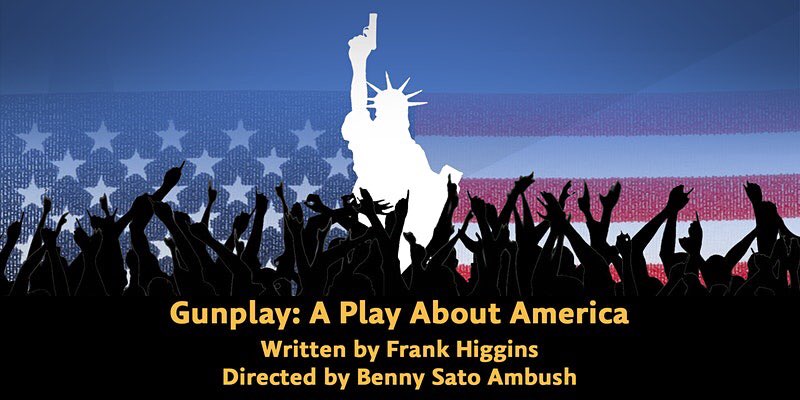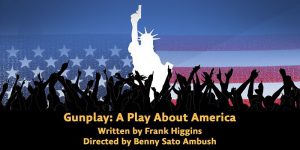
Written By: Ismenia Diego & John Schilling

This past weekend, the Department of Theater at Brooklyn College hosted “Gunplay: A Play About America” to discuss the nation’s gun use and how it has affected society.
Written by Frank Higgins and directed by Benny Sato Ambush, this production was pre-recorded and streamed on Vimeo, allowing the show to utilize special effects in post-production that would otherwise not be possible on stage.
In the beginning, the play has the cast use a gun hand gesture as if they were holding real guns. Each character then takes turns talking about the weapons, their history, and how they became normalized. This was enjoyable because of how the characters spoke, each taking turns speaking and finishing each other’s sentences, but this approach sets the confusing tone for the rest of the play.
Presumably, there were scenes where the show incorporated satire to emphasize how desensitized people have become to gun violence. One scene involves a conversation between actors portraying gender-bent versions of George and Martha Washington, and this really takes the audience aback.
On the one hand, it was great to see a play that attempts to start a discussion on the reality of gun violence and the aftermath of shootings. On the other hand, however, some of the creative decisions and the exaggerated acting are seemingly played for laughs, leaving audiences wondering what the play is actually trying to accomplish. Is it meant to raise awareness or make a joke about the issue?
However, it is worth mentioning that the play’s approach was more interesting than a traditional play because it was broken down into skits, and the cast succeeds at transforming themselves into different characters throughout their performance with well-designed costumes.
The downside to this is that some of these skits tended to talk in circles about the issue, and this quickly felt repetitive. So despite knowing that the skits were centered around gun violence, it was difficult to figure out what the overarching message actually was for some of them. These skits seem to emphasize talking about guns and gun violence, but they don’t actually say much.
Despite the confusion of some skits, there were others that were memorable and rightfully so. One that stood out involved a reporter interviewing a young girl, who claims her mother makes her stay indoors and keep the curtains closed so that no one can shoot them. As sad as it was, it highlighted an unfortunate reality for many children.
Perhaps the most unique part of the play was another skit that shed light on gun violence differently. It involved a police officer who talked about a domestic violence call she received in which a man took an officer’s gun and pointed it at his wife.
Reflecting on this, the officer says, “Take away the guns, take away the love. You’ll take away half the murders.”
A chilling reminder that many murders through shootings are committed by someone who knows the victim personally and not just strangers. It was refreshing to hear this perspective as it served as a reminder that gun violence can sometimes be closer to home than some actually realize.
Though the play, as a whole, had an intriguing creative vision, it was draining to see the same issue being displayed over a two-hour time frame that was not consistently expressed within a single storyline and jumped around in a choppy fashion.
For those interested in content regarding social issues, this would be a good play to watch, but if you search for something traditional, you will be disappointed.
